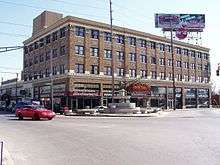Fountain Square, Indianapolis

Fountain Square is one of seven designated cultural districts in Indianapolis, Indiana. Located at Fountain Square are three designated national historic districts: the Laurel and Prospect District, State and Prospect District, and Virginia Avenue District.[1] They were listed on the National Register of Historic Places in 1983.[2]
History

In 1835, Calvin Fletcher and Nicholas McCarty purchased a 264-acre (1.07 km2) farm in what would become the Fountain Square neighborhood. Although the earliest settlement was sparse and primarily residential, substantial settlement and rapid commercial growth occurred in the area beginning in the 1870s. Much of the development was fueled by a large number of German immigrants settling in the area. German and German-American merchants helped to establish much of the character in this neighborhood.
The Virginia Avenue corridor began to emerge as the South side's commercial center in the 1860s. When the Citizen's Street Railway Company laid tracks down Virginia Avenue and located a turnaround at the intersection of Virginia Avenue with Shelby and Prospect Streets in 1864, the neighborhood began to be known as "The End" by local residents.
Fountain Square enjoyed continued growth as the southside's primary commercial district. The opening of the Fountain Square State Bank (1909), the Fountain Square Post Office (1927), Havercamp and Dirk's Grocery (1905), Koehring & Son Warehouse (1900), the Fountain Square branch of the Standard Grocery Company (1927), the Frank E. Reeser Company (1904), Wiese-Wenzel Pharmacy (1905), the Sommer-Roempke Bakery (1909), the Fountain Square Hardware Company (1912), Horuff & Son Shoe Store (1911), Jessie Hartman Milliners (1908), the William H. and Fiora Young Redman Wallpaper and Interior Design business (1923), the Charles F. Iske Furniture Store (1910), The Fountain Block Commercial Building (1902), and the G. C. Murphy Company (1929), are examples of this phenomenon.
Fountain Square also played an important part in the Indianapolis theater heritage. The area had more operating theaters than could be found in any part of Indianapolis from 1910 to 1950. Fountain Square continued to fill the role of "downtown" for the south side well into the 1960s, offering multiple movie/vaudeville theaters, independent banks, a wide range of retail, and churches/social centers serving a range of ethnicities.
The 1950s witnessed the beginning of the economic decline as new developments further south eclipsed Fountain Square's long-standing role as the Southside's primary commercial center. The closing of all of the neighborhood's theaters provided an obvious example of Fountain Square's commercial decline. A symbolic example was the removal of Fountain Square's fountain to the Garfield Park Conservatory in 1954.
Between 1950 and 1970, neighborhood resident composition changed as the largely German, Irish, and Italian original residents moved further out. The construction of the interstate system in the 1970s led to the demolition of hundreds of homes and many businesses and churches, displacing residents and adding to the suburban flight that began in the 60s. This confluence of events triggered a 15-year period of decline.
The Fountain Square commercial area began to benefit from concentrated reinvestment in the late 1990s.
Today
Fountain Square is becoming better known as a home for unique restaurants, art galleries and studios, live entertainment, antiques, and small professional offices. Thanks to the efforts of Southeast Neighborhood Development, and projects like the Wheeler Arts Community and the Murphy Art Center, the area is developing as a primary live/work community for Indianapolis artists. The gradual transformation of the commercial district has attracted growing investment in surrounding residential areas, with both long-time residents and new homeowners participating in improving the quality of area homes. Neighborhood support services, such as the Fountain Square Branch of the Indianapolis Public Library, are becoming plentiful, and the area is becoming a home for organizations of all types.
Today the dance hall inside the building of the historic diner and bowling alley has been part of a revival of swing dancing.
Future
The designation of Fountain Square as one of Indiana's first urban Main Street programs, coupled with the distinction of being named as one of seven Indianapolis Cultural Districts, has the commercial district poised for further reinvestment and improvement. Long-term projects are in the planning stages, including upgrades to the street scape and fountain, developing additional public space, and creating gateways and directional signs that visually define Fountain Square as one of the unique neighborhoods of Indianapolis.
References
- ↑ "Indiana State Historic Architectural and Archaeological Research Database (SHAARD)" (Searchable database). Department of Natural Resources, Division of Historic Preservation and Archaeology. Retrieved 2016-08-01. Note: This includes Mary Toshach, Mary Ellen Gadski, James Reed, and Cecelia Boggs (February 1983). "National Register of Historic Places Inventory Nomination Form: Fountain Square Commercial Historic District" (PDF). Retrieved 2016-08-01. and Accompanying photographs
- ↑ National Park Service (2010-07-09). "National Register Information System". National Register of Historic Places. National Park Service.
External links
- Discover Fountain Square Cultural District
- Fountain Square Theater Building
- Historic Fountain Square Photo Essay
39°45′8″N 86°8′24″W / 39.75222°N 86.14000°WCoordinates: 39°45′8″N 86°8′24″W / 39.75222°N 86.14000°W